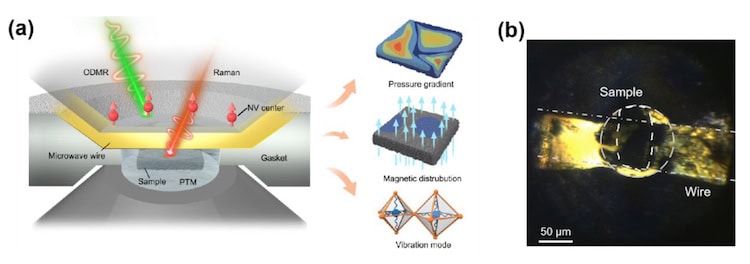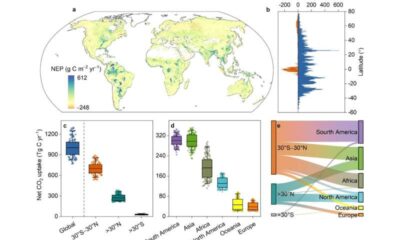Science
Quantum Sensors Unearth Meissner Effect in High-Pressure Nickelates

Physicists at the Chinese Academy of Sciences (CAS) have made a significant breakthrough in superconductivity research. They utilized diamond-based quantum sensors to provide the first unequivocal experimental evidence of the Meissner effect in bilayer nickelate materials under high-pressure conditions. This discovery could pave the way for developing advanced quantum detectors capable of operating in extreme environments.
Superconductors are materials that exhibit zero electrical resistance when cooled below a certain critical temperature, denoted as Tc. The Meissner effect, a key indicator of superconductivity, occurs when a material expels a magnetic field from its interior, allowing a magnet to levitate above the superconducting surface. Traditional superconductors, like solid mercury, require cooling with liquid helium due to their low Tc. In contrast, the discovery of unconventional superconductors, particularly those derived from copper oxides, has shifted the landscape since the late 1980s, with some exhibiting superconductivity above the boiling point of liquid nitrogen (77 K).
The quest for materials that can superconduct at even higher temperatures continues. In 2019, researchers at Stanford University identified nickel oxides, or nickelates, as potential high-temperature superconductors. Among these, the compound La3Ni2O7-δ, where δ ranges from 0 to 0.04, has garnered significant attention. Researchers led by Meng Wang from Sun Yat-Sen University reported signs of superconductivity in this material around 80 K, but only under the extreme pressures generated by a diamond anvil cell (DAC).
The DAC exerts pressures exceeding 400 GPa, presenting challenges in detecting the Meissner effect due to limited sample volume and the interference of competing phases within the material. As Xiaohui Yu from CAS’s Institute of Physics explains, these factors complicate the application of sensitive magnetic measurement techniques.
In their recent study, Yu and colleagues employed nitrogen-vacancy (NV) centres embedded in the DAC as in-situ quantum sensors to accurately track and visualize the Meissner effect in pressurized bilayer La3Ni2O7-δ. This innovative magnetic sensing technique demonstrated both high sensitivity and high spatial resolution, perfectly suited for the DAC’s high-pressure environment. By applying a small external magnetic field of approximately 120 G, they captured optically detected magnetic resonance (ODMR) spectra of the NV centres, enabling them to extract local magnetic fields from the resonance frequencies.
“We directly mapped the Meissner effect of the bilayer nickelate samples,” Yu stated, highlighting the clear distinction between the diamagnetic region and areas where magnetic flux was concentrated.
The research team commenced their project in late 2023 after receiving single-crystal samples of La3Ni2O7-δ. Initially, their experiments yielded no substantial results, leading them to enhance the quality of their samples. They transitioned to polycrystalline samples, doping them with praseodymium to create La2PrNi2O7, which exhibited a nearly pure bilayer structure and a significantly stronger demagnetization signal.
Yu elaborated on this advancement, noting that the diamagnetic signal from the praseodymium-doped samples was approximately five times stronger than that of the original nickelate samples. This improvement aligns with the higher quality of the Pr-doped materials.
Physicist Jun Zhao from Fudan University, who was not involved in the research, called the measurements “an important step forward” for nickelate studies. He emphasized that the success of these technically challenging measurements represents both experimental creativity and scientific significance. Zhao added, “More broadly, their result strengthens the case for pressurized nickelates as a new platform to study high-temperature superconductivity beyond the cuprates.”
The NV centres used in this research hold potential for measuring various physical quantities under high pressure, including strain and temperature distribution. Yu and his team are exploring further applications for these quantum sensors in high-pressure environments, with their findings published in the National Science Review.
This pivotal discovery not only advances the understanding of superconductivity but also opens new avenues for technological applications, potentially transforming fields ranging from medical imaging to energy transmission.
-

 World2 weeks ago
World2 weeks agoCoronation Street’s Shocking Murder Twist Reveals Family Secrets
-

 Entertainment1 week ago
Entertainment1 week agoAndrew Pierce Confirms Departure from ITV’s Good Morning Britain
-

 Entertainment5 months ago
Entertainment5 months agoKate Garraway Sells £2 Million Home Amid Financial Struggles
-

 Entertainment4 months ago
Entertainment4 months agoAnn Ming Reflects on ITV’s ‘I Fought the Law’ Drama
-

 Entertainment1 month ago
Entertainment1 month agoCoronation Street Fans React as Todd Faces Heartbreaking Choice
-

 Health4 months ago
Health4 months agoKatie Price Faces New Health Concerns After Cancer Symptoms Resurface
-

 World1 month ago
World1 month agoBailey Announces Heartbreaking Split from Rebecca After Reunion
-

 Entertainment2 weeks ago
Entertainment2 weeks agoTwo Stars Evicted from I’m A Celebrity Just Days Before Finale
-

 World2 weeks ago
World2 weeks agoKevin Sinfield Exceeds Fundraising Goal Ahead of Final Marathons
-

 Entertainment4 months ago
Entertainment4 months agoCoronation Street’s Carl Webster Faces Trouble with New Affairs
-

 Entertainment3 months ago
Entertainment3 months agoWhere is Tinder Swindler Simon Leviev? Latest Updates Revealed
-

 Entertainment5 months ago
Entertainment5 months agoMarkiplier Addresses AI Controversy During Livestream Response

















